Yamaha Motor Co., Ltd. is a Japanese multinational manufacturer of motorcycles, marine products such as boats and outboard motors, and other motorized products. The company was established in 1955 upon separation from Yamaha Corporation, and is headquartered in Iwata, Shizuoka, Japan. The company conducts development, production and marketing operations through 109 consolidated subsidiaries as of 2012.
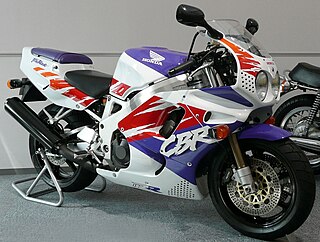
The Honda CBR900RR, or FireBlade in some countries, is a 900 cc (55 cu in) sport bike, part of the CBR series introduced in 1992 by Honda. It was the first of a series of large-displacement Honda models to carry the RR suffix. The development of the first generation CBR900RR was led by Tadao Baba.
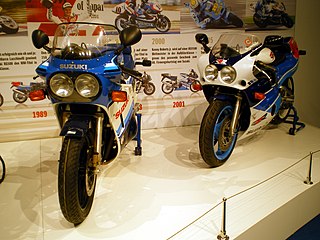
The Suzuki GSX-R is a series of sport bikes made by Japanese manufacturer Suzuki. Current models are the GSX-R125 and GSX-R150 since 2017; GSX-R600 which was manufactured from 1992 to 1993, and then since 1997; the GSX-R750 since 1985; and the GSX-R1000 since 2001.
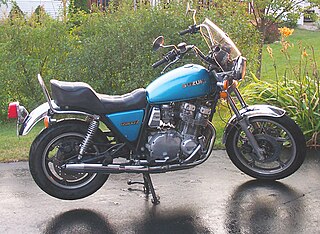
The Suzuki GS series was Suzuki Motor Corporation's first full range of 4-stroke powered road motorcycles, having previously almost exclusively manufactured 2-stroke machines. Suzuki had produced the 4-stroke Colleda COX 125cc and 93cc 4-stroke single-cylinder machines in 1955 however the rest of Suzuki's production from 1952 to 1976 had been increasingly sophisticated two-stroke road machines, whose ultimate expression was the 750cc 3-cylinder water-cooled GT750.

The Yamaha YZF-R1 is a 1,000 cc (61 cu in) class sports motorcycle made by Yamaha. It was first released in 1998, undergoing significant updates in 2000, 2002, 2004, 2006, 2007, 2009 and 2015.
"Genesis" is Yamaha's marketing name for a range of innovative high performance multi-valve motorcycle engines. The flexible design of the engine allowed Yamaha to use it on a variety of configurations, from sport bikes to outboard engines.
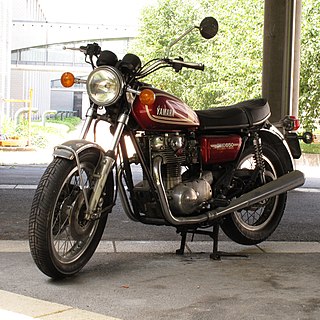
The Yamaha XS650 is a mid-size motorcycle made by Yamaha Motor Company. The standard model was introduced in October 1969,and produced through 1979. The "Special" cruiser model was introduced in 1978 and produced through 1985. The XS650 began with the 1955 Hosk SOHC 500 twin. After about 10 years of producing 500 twin, Hosk engineers designed a 650 cc twin. Later the Hosk company was acquired by Showa Corporation, and in 1960 Yamaha had bought Showa with Hosk's early design of 650 cc twin.

The Yamaha YZF600R is a 599 cc (36.6 cu in) sports bike made by Yamaha from 1996 to 2007.

The Yamaha FZ1 is a naked bike made by Yamaha Motor Company in Japan.

The Honda CBR600RR is a 599 cc (36.6 cu in) motorbike made by Honda since 2003, part of the CBR series. The CBR600RR was marketed as Honda's top-of-the-line middleweight sport bike, succeeding the 2002 Supersport World Champion 2001–2006 CBR600F4i, which was then repositioned as the tamer, more street-oriented sport bike behind the technically more advanced and uncompromising race-replica CBR600RR. It carried the Supersport World Championship winning streak into 2003, and on through 2008, and won in 2010 and 2014.

The Suzuki GSX-R1000 is a supersport motorcycle made by Suzuki. It was introduced in 2001 to replace the GSX-R1100 and is powered by a liquid-cooled 999 cc (61.0 cu in) inline four-cylinder, four-stroke engine although originally 988 cc (60.3 cu in) from 2001 to 2004.

A motorcycle frame is a motorcycle's core structure. It supports the engine, provides a location for the steering and rear suspension, and supports the rider and any passenger or luggage. Also attached to the frame are the fuel tank and battery. At the front of the frame is found the steering head tube that holds the pivoting front fork, while at the rear there is a pivot point for the swingarm suspension motion. Some motorcycles include the engine as a load-bearing stressed member; while some other bikes do not use a single frame, but instead have a front and a rear subframe attached to the engine.

The Yamaha FZR600 is a sports motorcycle produced by Yamaha between 1988 and 1995. It was the successor to the FZ600 and was replaced by the Yamaha YZF600R in 1996. It had a steel Deltabox frame and swingarm, similar in appearance to the alloy Deltabox frame introduced three years earlier on the 1WG FZR400.
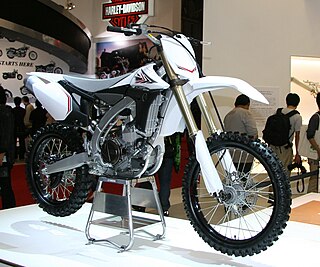
The Yamaha YZ450F is a four-stroke racing motocross bike built by Yamaha Motor Corporation. It was the successor to the previous YZ426F which was discontinued in 2003. It is credited by Cycle World and Dirt Rider magazines as the bike that started the four-stroke dirt bike revolution. The 2006 YZ250F and YZ450F were the first production motorcycles equipped with titanium suspension springs.

The Yamaha FZ150i is a lightweight 150 cc motorcycle manufactured by Yamaha Motor Company exclusively for Southeast Asian markets. It was launched in Indonesia in June 2007 at Palembang Indah Mall, Palembang and then Malaysia in January 2008 at First World Hotel, Genting Highlands as the first completely knocked down (CKD) bike to be fuel-injected in Asian motorcycle market.

The Yamaha FZ750 is a sports motorcycle produced by Yamaha Motor Corporation between 1985 and 1991. The FZ750 is notable for several reasons, perhaps the most radical being the 5-valve cylinder head with a radial arrangement. This became something of a Yamaha trademark. The FZ750 would be the first bike in the Genesis design concept.

The Yamaha YZF1000R Thunderace was a motorcycle produced by Yamaha from 1996 until 2005.
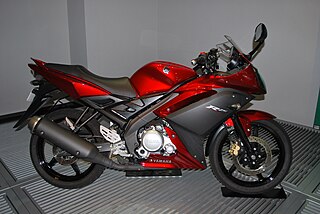
The Yamaha YZF-R15 is a single cylinder sport bike made by Yamaha Motor Company since 2008. In September 2011, the second iteration, called v2 .0, was released in India, and in April 2014 it was released in Indonesia. In January 2017, the third iteration of the bike, called v3.0, was launched in Indonesia.
The FZ-600 was Yamaha's first true attempt at a 600 cc "Race Replica" with the growing interest in MotoGP Road Racing taking hold in the mid-1980s. Many FZ owners confuse their bikes with the later FZR models due to similar name and body styling.


















